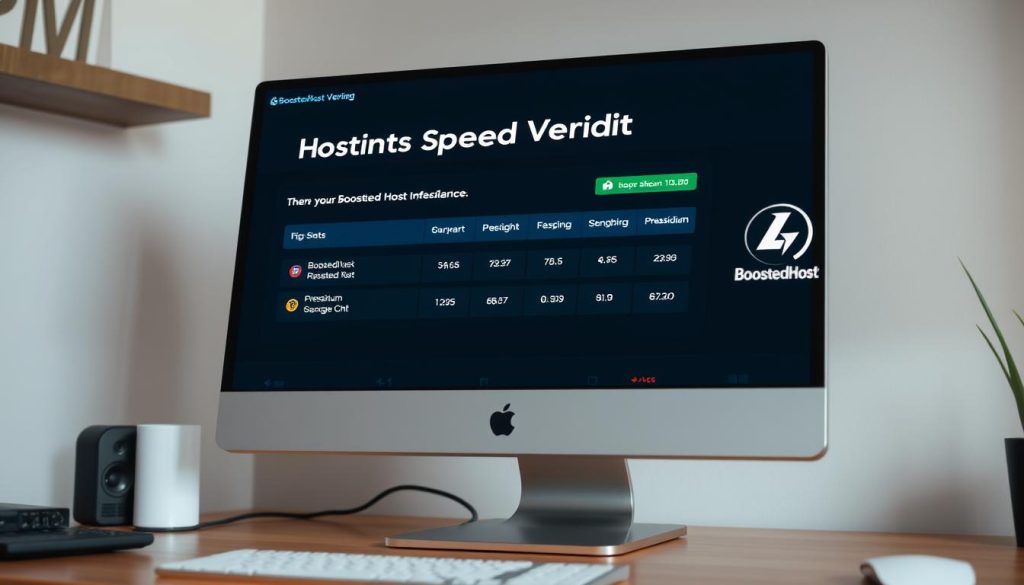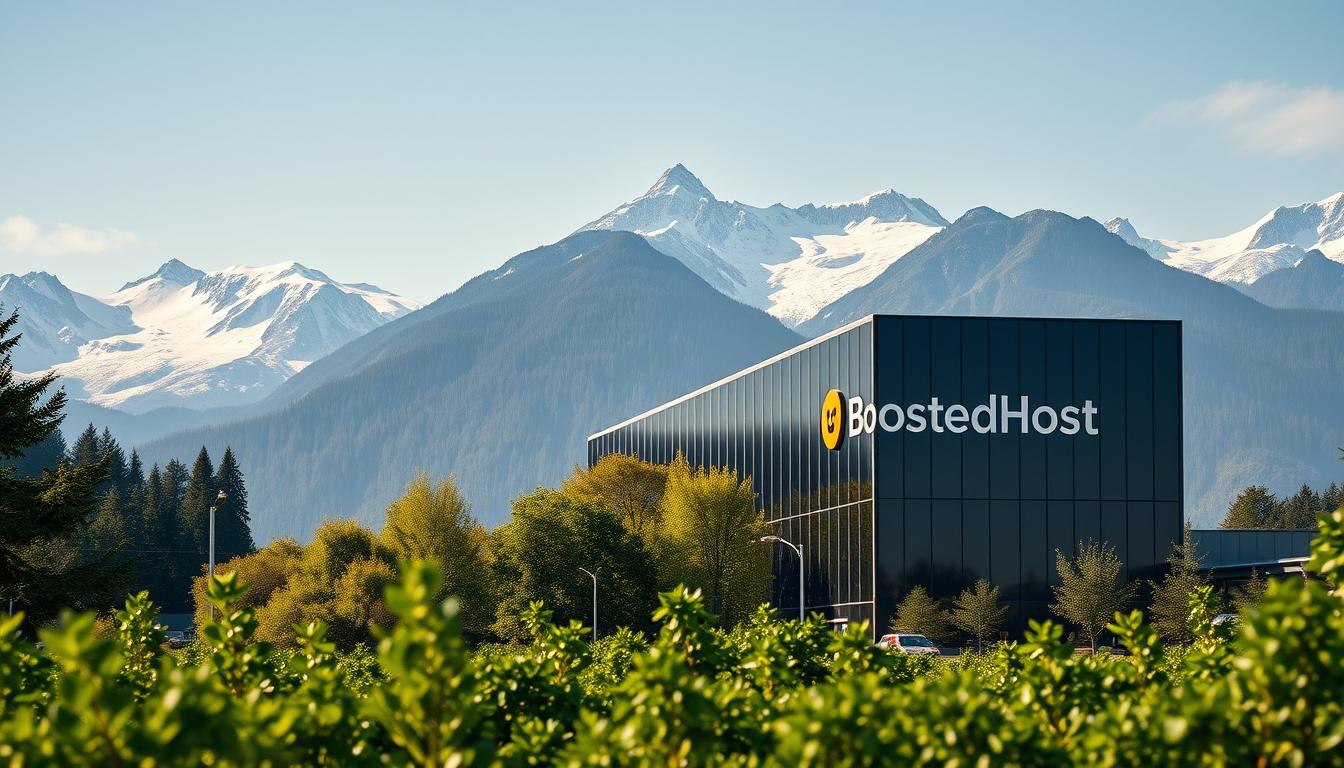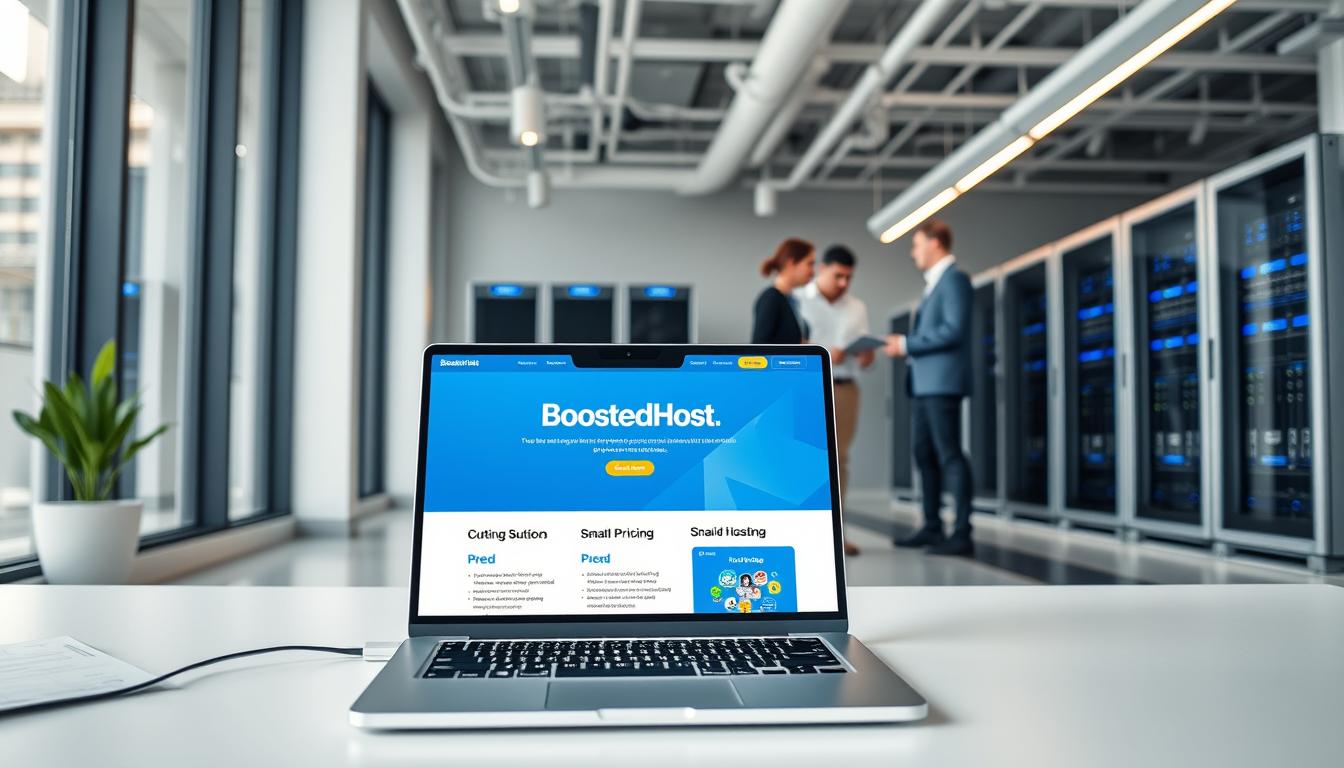We remember the sleepless nights before a product launch — the fear that a slow server or surprise fees would ruin momentum. We felt that pressure too. That is why we built this straight, data-led comparison for U.S. businesses choosing a hosting partner.
We cut the noise and focus on what matters to your bottom line: performance, uptime, pricing transparency, included features, tooling, and support. Expect clear answers about plans, month-to-month pricing, and which option fits your growth timeline.
Our lens favors real-world results. We highlight a premium Swiss-based stack with ultra-fast LiteSpeed, free SSL, daily backups, an included global CDN, and an AI site builder that gets a professional website live in under five minutes. We also acknowledge the competitor’s fault-tolerant clusters and enterprise tooling so you can choose with confidence.
Key Takeaways
- We compare hosting by performance, uptime, pricing, features, and support.
- One provider offers transparent plans and many built-in features with no add-ons.
- Another targets enterprise WordPress with fault-tolerant clusters and DevOps access.
- Choose based on site type: lean SMBs vs. high-scale agencies or enterprise.
- By the end you’ll match your website needs to the right plan and pricing.
Quick verdict at a glance: who wins for speed, value, and support
Here’s a concise verdict that shows which hosting option leads on speed, value, and real support. We prioritize fast server response, transparent plans, and included features that save time and money.

Short summary—our hands-on testing shows one provider edges out for raw speed. LiteSpeed acceleration and globally distributed points of presence deliver sub-200ms TTFB on average. That translates to faster page loads and better web performance for your site.
- Speed: Edge to LiteSpeed acceleration and sub-200ms server response.
- Uptime: 99.99% availability with daily backup and malware protection included.
- Value: SSL, daily backups, malware scanning, CDN, and Orbit AI builder included—no surprise fees.
- Support: 24/7 expert team resolves most tickets in minutes; the other provider offers direct DevOps access for complex workflows.
| Category | Speed | Uptime | Included features |
|---|---|---|---|
| Our top pick | LiteSpeed, sub-200ms | 99.99% | SSL, backups, malware, CDN, Orbit AI |
| Enterprise option | Multilayer caching, sub-200ms goal | High, cluster-based | Clustering, DevOps, CDN add-on ($10/100GB) |
What businesses should compare: user intent, site type, and growth stage
Decide hosting by your goal: launch fast with predictable monthly plans, or prepare for enterprise-grade control under heavy campaigns. We focus on practical signals—team skill, traffic profile, and growth timeline—to match a plan to real needs.
Startup and SMB needs
Startup and SMB: predictable plans, included features, and fast time-to-live
Early-stage businesses benefit from transparent pricing and bundled features. Look for free SSL, daily backups, malware protection, and an AI site builder to reduce time and cost.
Inclusive plans cut surprises. If your team lacks DevOps, choose managed hosting that handles routine tasks and support.

Agency and enterprise: fault tolerance, DevOps, and heavy traffic patterns
Agencies need multi-node clusters, dynamic load balancing, and staging workflows. High-traffic campaigns or bursty PPC require robust caching and predictable billing for CDN bandwidth.
| Use case | Key needs | Recommendation |
|---|---|---|
| Startup / SMB | Predictable month pricing, included features, fast site launch | Managed plan with AI builder and CDN included |
| Agency / Enterprise | Fault-tolerant clusters, DevOps access, flexible scaling | Clustered architecture with staging and DevOps support |
| Seasonal retail | Burst traffic, visits spikes, CDN and caching | Plan for headroom and bandwidth forecasting |
BoostedHost overview: premium Swiss-based hosting engineered for speed
This premium Swiss platform combines raw server power with practical tools to get sites live quickly. We built the stack for teams that need predictable performance, clear plans, and fewer surprises.
Core infrastructure: LiteSpeed servers cut TTFB and reduce CPU use. Multi-region data centers (Switzerland, USA, Europe, Asia) place your site near visitors for lower latency.
Ultra-fast LiteSpeed servers, free SSL, daily backups, malware protection
Included essentials: free SSL, daily backups, and always-on malware protection are active from day one. That reduces admin time and lowers risk.
Global CDN is included with no separate billing. We guarantee 99.99% uptime and aim for sub-200ms global TTFB on average.
Orbit AI Website Builder: launch a professional site in under 5 minutes
Speed to market matters. Orbit AI builds a professional website in under five minutes. It trims design time and gets your domain and website ready fast.
- Support for PHP, Node.js, Python, and WooCommerce.
- Transparent pricing and flexible plans for individuals, SMBs, and agencies.
- 24/7 expert support that resolves most requests in minutes.
| Feature | What you get | Why it matters |
|---|---|---|
| Server | LiteSpeed, multi-region | Lower TTFB, faster page render |
| Security | Free SSL, malware protection | Reduce risk and manual upkeep |
| Backup & CDN | Daily backups, global CDN | Faster delivery and safer restores |
| Tools & support | Orbit AI builder, 24/7 support | Launch fast and resolve issues quickly |
Pressidium overview: enterprise-grade managed WordPress hosting
When uptime and predictable production releases matter, this managed WordPress stack puts resilience first. We see a clear enterprise focus: fault-tolerant clustering, fast failover, and tools built for agencies managing many sites.
Multi-node cluster and adaptive caching
Architecture: A multi-node server cluster and dynamic load balancing keep traffic flowing during spikes.
They use multilayer adaptive caching (Varnish-based) to aim for sub-200ms responses under load. That helps maintain speed as visits climb.
Agency workflows and DevOps-first support
Staging environments spin up in under a minute. Managed updates run with a pre-update backup. Free migrations reduce friction when moving client sites.
- Direct DevOps engineer access—no tiered handoffs.
- WAF, malware monitoring and removal included.
- CDN offered as an add-on ($10 per 100GB); budget for bandwidth as you scale.
| Feature | What it gains you | Notes |
|---|---|---|
| Clustering | Fault tolerance and fast failover | Targets enterprise uptime |
| Staging & updates | Smoother releases | Pre-update backups included |
| Support | DevOps engineers on call | Enterprise plans start at $790/month |
Summary: This provider delivers an enterprise-grade managed WordPress hosting option that favors agencies and large sites. Compare these strengths—clustering, caching, and direct DevOps help—against hosts that bundle CDN, backups, and an AI builder into more transparent plans.
BoostedHost vs Pressidium: performance, uptime, and global delivery
High-performance hosting must pair low latency with predictable availability. We compare real-world metrics and billing to help you pick a plan that scales without surprise costs.
Uptime and TTFB
99.99% uptime and sub-200ms global TTFB are the headline claims for one platform. That reliability matters for conversions and crawl budget.
Multilayer caching and server response
Pressidium’s multilayer adaptive caching and dynamic load balancing aim for sub-200ms under load. That design keeps delivery stable during traffic spikes.
“Real speed requires both edge delivery and consistent backend response — one without the other still hurts conversions.”
CDN and cost clarity
One host includes a global CDN in every plan, which keeps month-to-month bills predictable as media libraries grow.
The other bills CDN bandwidth at $10 per 100GB — small at first, material at scale. Plan for peak campaign traffic and bandwidth overages.
| Metric | Included | Notes |
|---|---|---|
| Uptime | 99.99% | Daily backups and malware protection included |
| TTFB | Sub-200ms | LiteSpeed vs. multilayer caching |
| CDN | Included / $10 per 100GB | Inclusive option reduces billing variance |
- Performance parity: Both targets hit sub-200ms, but stacks differ.
- Latency planning: Pick regions nearest U.S. users to minimize round trips.
- Budgeting: Inclusive CDN simplifies monthly cost forecasting.
Speed stack and caching: LiteSpeed acceleration vs. multilayer caching
Speed wins attention; the stack behind your site decides if you keep it. We compare two clear approaches to make pages load fast and stay fast under load.
Edge caching, opcode/object caching, and PHP acceleration form the core of modern web performance. One stack uses LiteSpeed with LSAPI, built-in server caching, HTTP/3, and on-the-fly compression to lower CPU use and cut TTFB.
The other relies on a multilayer adaptive cache. It uses Varnish at the edge and RAM-based opcode and object caches for PHP 7+ sites. That setup profiles traffic and caches at multiple tiers.
Real-world impact on page load, Core Web Vitals, and crawl budget
- Faster TTFB: server-level caching and PHP acceleration reduce PHP execution time and database calls.
- Better Core Web Vitals: edge caching tightens LCP and FCP by serving static assets from nearby nodes.
- Crawl budget: lower TTFB lets search bots fetch more URLs in the same time window.
- E‑commerce: carts and checkout bypass caches; catalog pages use aggressive rules.
“Real speed requires both edge delivery and consistent backend response — one without the other still hurts conversions.”
| Layer | LiteSpeed approach | Multilayer approach |
|---|---|---|
| Edge | Built-in CDN integration, HTTP/3 | Varnish + multi-tier edge caching |
| Opcode/Object | LSAPI + server cache | RAM-based opcode and object caches |
| Best for | Simpler plans with included speed | WordPress sites needing fine-grained control |
Data center locations and latency for U.S. audiences
Choosing the right data center locations cuts latency and keeps your site fast for target users. We align infrastructure choices to reduce round-trip time and improve the web experience for U.S. visitors.
Where you place origin servers matters. For U.S.-focused traffic, a nearby server reduces TTFB and speeds page loads. That matters for checkout flows, dashboards, and media-heavy pages.
Global coverage and regional fit
Our platform offers Switzerland, USA, Europe, and Asia locations so you can place workloads near core users. This lowers latency and helps media-heavy sites serve assets faster with included CDN features.
APAC reach and enterprise regions
Pressidium supports North America, Europe, Japan, Southeast Asia & Oceania. That gives extended APAC reach for multi-region sites and distributed teams.
- Choose U.S. data centers to cut round-trip time for American users.
- Multi-region redundancy helps distributed teams and global customers without latency penalties.
- Plan migrations as traffic shifts to keep the origin close to main users and reduce load on the database and storage.
| Region | Coverage | Best for |
|---|---|---|
| USA | Available | U.S. audiences, low-latency ecommerce |
| Europe | Switzerland & wider EU | EU traffic, data residency |
| APAC | Asia / Japan / SE Asia & Oceania | Regional reach, global campaigns |
Security posture: hardening, malware protection, and WAF
A layered security posture keeps attackers out and gets you back online when things go wrong. We design defenses to stop threats, detect risks, and restore sites fast. That reduces downtime and keeps your web traffic steady.
Basics included across plans: free SSL for encrypted transport and daily backups for fast recovery. We run always-on malware scanning and removal so infected files are detected and cleaned automatically.
Pressidium complements server monitoring with a managed WAF, network firewalling, and bad-bot filtering. They also offer automatic WordPress updates with pre-update snapshots to lower update risk.
Security must be layered — transport, request filtering, and post-breach hygiene. Staging environments and snapshots limit blast radius by keeping risky changes off the production site until validated.
- Free SSL and daily backups included from day one.
- Always-on malware scanning plus automated removal.
- Managed WAF, firewall, and bot filtering for higher-risk sites.
- Pre-update snapshots and staging to reduce update failures.
| Layer | Feature | Benefit |
|---|---|---|
| Transport | Free SSL | Encrypts traffic, protects credentials |
| Detection | Always-on malware scanning | Finds and removes infections quickly |
| Filtering | Managed WAF & bot filtering | Blocks attacks and bad traffic |
| Recovery | Daily backups & pre-update snapshots | Fast restore with minimal downtime |
“Security is layered — SSL, WAF, scanning, and backups work together to reduce risk and speed recovery.”
Features comparison: what’s included vs. paid add-ons
We map essential features so you can choose a plan that fits your web needs and monthly budget.
All-in-one plans bundle essentials and reduce admin time. One host includes free SSL, daily backups, always-on malware protection, and a global CDN in each plan. That means fewer invoices and predictable month-to-month costs.
Included essentials and billing clarity
What matters most: SSL for secure domains, automated backup and restore, malware scanning, and global CDN delivery. These cut time spent on security and recovery. They also simplify support and operations.
Agency tools and add-ons
The other provider focuses on agency workflows. You get free site migrations, robust staging and cloning, and an enterprise multi-node architecture for resilience.
CDN is available as an add-on at $10 per 100GB—fine at low usage, material at scale. Budget for bandwidth as visits grow.
| Feature | Included | Add-on / Notes |
|---|---|---|
| SSL | Yes | No extra fee |
| Daily backups | Included | Fast restores |
| CDN | Bundled in one plan | $10 / 100GB add-on on the other |
| Migrations & staging | Basic tools | Free migrations & deep staging for agencies |
Decision guide: if you want fewer billing lines and predictable monthly pricing, choose the all-in-one option. If you manage many client sites and need staging plus DevOps depth, the enterprise-focused provider may suit you better.
Pricing transparency and total cost per month
Clear pricing turns hosting from a guessing game into a predictable line item for your P&L. We break monthly costs into tiers, add-ons, and operational savings so you can budget with confidence.
No hidden fees and clear plan tiers.
Our all-in-one plans list monthly prices, included features, and limits. Essentials — SSL, daily backup, CDN, and basic email — are bundled. That lowers the total cost of ownership and reduces vendor juggling.
Entry-level to enterprise pricing.
Managed WordPress plans start at accessible price points. Enterprise options begin at $790 per month and add DevOps support, clustering, and advanced staging.
Add-on costs to forecast.
- CDN bandwidth — expect $10 per 100GB on some plans.
- Storage growth and overages — forecast media-heavy months.
- Email — some enterprise plans exclude email hosting; plan for a separate service.
| Cost element | What to expect | Budget tip |
|---|---|---|
| Monthly plan | Tiered pricing with clear limits | Pick a plan that fits peak traffic |
| CDN | $10 / 100GB where charged | Estimate monthly visits and media bandwidth |
| Migrations & support | Free migrations; managed updates on enterprise plans | Leverage free migration to lower upfront costs |
Managed WordPress hosting experience and tooling
We design managed workflows to save teams time and reduce risk. The right tooling shortens launch time and makes updates safer. That matters when you run client sites, product launches, or high-traffic campaigns.
Orbit AI builder speeds launches. It assembles a professional website in minutes so teams can ship content the same day. For businesses that want a fast site and predictable plans, this cuts setup time and lowers operational overhead.
Orbit AI builder vs. a portal built for staging and cloning
One approach favors speed and simplicity. Orbit AI handles templates, assets, and domain configuration fast. You get a working site and start publishing in a single session.
The other approach focuses on WordPress workflows. Its portal offers staging in under a minute, easy cloning, and managed updates for clients that need careful testing before deployment.
Backup restore flows and pre-update snapshots
Daily backups with quick restores are included on the faster-launch stack. Restores are straightforward and reduce downtime after mistakes or data loss.
For staged updates, the portal performs a full pre-update snapshot. That gives you a verified rollback point before applying changes to production.
“Stage, test, and roll forward with confidence — both platforms streamline rollback and recovery.”
- Rapid launch: Orbit AI builds a professional site in minutes.
- Staging & cloning: Portal-level tools spin up test sites fast for safe testing.
- Backups: daily restores vs. pre-update full snapshots — both reduce risk.
- Workflow fit: pick speed and simplicity or deep staging pipelines for many client sites.
- Developer happiness: tight caching and PHP tuning shrink build-test cycles.
| Tooling area | Speed-focused builder | Portal with staging |
|---|---|---|
| Launch time | Minutes — Orbit AI templates | Minutes for staging; cloning adds control |
| Backup flow | Daily backups, fast restores | Pre-update full snapshots, restore points |
| Best for | Businesses needing fast site launches and predictable plans | Agencies managing many client sites and complex updates |
Developer stack and CMS flexibility
Modern web projects often combine CMS pages with APIs and microservices — pick a host that matches that mix.
Multi-runtime support: One platform supports PHP, Node.js, and Python alongside WooCommerce. That lets teams run a storefront, background workers, and custom APIs in one account. It cuts setup time and reduces cross-account overhead.
WordPress-optimized stack: The other provider focuses on a tuned WordPress environment. It runs PHP 7+ with multilayer enterprise caching and RAM-based object/opcode stores for consistent page delivery under load.
Choose the flexible stack when you need to deploy microservices, custom apps, or a headless frontend with the same hosting plan. Choose the optimized stack when your portfolio is WordPress-heavy and predictable tuning matters.
Commerce readiness: Both support WooCommerce and keep cart and checkout flows safe with edge rules so traffic spikes don’t break purchases. For a dedicated WooCommerce plan see WooCommerce hosting.
| Capability | Multi-runtime stack | WordPress-optimized stack |
|---|---|---|
| Runtimes | PHP, Node.js, Python | PHP 7+ only (tuned) |
| Caching | Built-in server cache, CDN | Multilayer caching, RAM object/opcode |
| Best for | Full‑stack apps + CMS | Large WordPress portfolios |
Support responsiveness and resolution time
When a launch or campaign spikes traffic, the right support team makes the difference. Fast answers keep sites live and teams focused on growth. We measure support by response time and by the speed of actual fixes.
24/7 rapid-response support
Our support operates around the clock. Most tickets get resolved in minutes, not hours. We give clear, action-oriented steps and proactive guidance so your website and server recover fast.
Direct DevOps access for complex incidents
The enterprise option routes you straight to qualified DevOps engineers. There are no tiered handoffs. That model suits agencies needing architecture-level input, deep security checks, and scaling help.
- Fast resolutions—most requests handled in minutes.
- Clear communication—steps, timelines, and follow-up.
- DevOps-first support—direct access for complex WordPress incidents.
- High-stakes readiness—short queues during launches and campaigns.
- Recommendation: SMBs favor rapid 24/7 help; agencies prefer direct DevOps access.
“Support speed and quality are as crucial as uptime. Choose the model that matches your team and risk profile.”
Migrations, email, domains, and day-to-day operations
Smooth operations start with predictable, low-friction admin and reliable support. Migration, email, and domain moves can eat time if they’re not planned. We focus on practical steps that keep your website online and your team productive.
Free managed migrations and streamlined setup workflows
Free managed migrations reduce friction when you move multiple sites. The enterprise host offers full, managed site transfers and handles database and permalinks during cutover.
Staging and managed updates are part of that workflow. Teams can test changes, run a pre-update snapshot, and push to production with confidence. That speeds the migration time and lowers risk.
Email hosting note and domain workflows
Email planning matters: the enterprise option does not include email hosting. Provision a separate email provider before cutover to avoid downtime for communications.
Domain and DNS changes should be staged. Use TTL reduction, confirm MX and SPF records, and coordinate the final switch during low-traffic hours to minimize disruption.
- Day-to-day ease: an all-in-one host with included SSL, daily backups, malware protection, and CDN cuts routine tasks.
- Cutover checklist: backups, staging verification, DNS TTL swap, and email provisioning.
- Operational predictability: 24/7 support speeds fixes so your team spends less time firefighting.
| Area | What to expect | Operational tip |
|---|---|---|
| Migration | Free managed transfers, DB and permalink handling | Schedule during off-peak hours |
| Not included on the enterprise option | Pre-provision external email and test MX records | |
| Domain & DNS | Assisted cutovers and clean TTL swaps | Reduce TTL 24 hours prior to move |
Use-case recommendations: match the right host to your plan, traffic, and resources
Pick hosting that fits your growth plan and daily operations. We focus on real needs — predictable pricing, included features, and appropriate scaling for traffic.
Individuals and small businesses prioritizing price transparency and features
Choose a simple, all-in-one plan when you want clear month-to-month pricing and fewer admin tasks. Look for free SSL, daily restores, an included CDN, and an AI site builder to cut setup time.
That approach keeps costs predictable and reduces time spent on server upkeep. It fits blogs, small stores, and solo entrepreneurs who need a fast website without DevOps.
Agencies and enterprises needing fault-tolerant clusters and scaling
Opt for multi-node clusters and direct DevOps access when you manage many client sites or large campaigns. Expect advanced staging, fast failover, and enterprise SLAs.
Note: enterprise plans start at $790/month and may charge CDN bandwidth as an add-on. That pricing makes sense when reliability and deep tooling outweigh simpler monthly plans.
- Individuals / SMBs: all-in-one host with inclusive features and clear pricing.
- Budget clarity: pick predictable plans to avoid surprise month charges.
- Agencies / Enterprises: choose clustered architecture and DevOps support for scale.
- Hybrid path: start on a value plan and move to enterprise tooling as needs grow.
- Traffic surges: both handle spikes — one via LiteSpeed + CDN, the other via dynamic load balancing and multilayer caching.
“Match the host to your team and traffic profile — the best plan saves time and prevents surprises.”
| Use case | Recommended plan | Why it fits |
|---|---|---|
| Solo sites / small businesses | All-in-one managed plan | Inclusive features, predictable month pricing, fast launch |
| Growing agencies | Enterprise clustered plan | DevOps access, staging, fault tolerance for many websites |
| Mixed needs / scaling | Start value → migrate to enterprise | Low setup cost first; migrate when traffic and complexity grow |
Conclusion
Conclusion
We close with a practical, unbiased view. Choose the host that matches your team, timeline, and tolerance for complexity.
If you want maximum value with minimal complexity, pick the all-in-one option: LiteSpeed servers, 99.99% uptime, sub-200ms TTFB, and inclusive SSL, backups, malware protection, and CDN. Orbit AI cuts launch time so your team spends less time on setup and more on marketing and product.
If you manage many client sites and need deep control, consider the enterprise option: clustered architecture, direct DevOps access, and agency workflows. Budget for CDN add-ons and enterprise tiers when forecasting month costs.
Final word: align your choice to your capacity, growth horizon, and required level of control. We recommend matching the plan to your people, not just the feature list.
FAQ
Which host is faster for real-world WordPress sites?
Both providers deliver strong speed, but their approaches differ. One uses LiteSpeed acceleration, edge caching, and global CDN included in plans to drive sub-200ms TTFB and fast Core Web Vitals. The other uses a multilayer adaptive cache with a multi-node cluster and dynamic load balancing to hit similar server-response targets. Pick the host whose stack aligns with your stack — LiteSpeed for PHP-optimized sites and multilayer caching for clustered enterprise setups.
How do uptime and reliability compare?
Both services commit to high uptime. One advertises 99.99% uptime with enterprise-grade monitoring and daily backups. The other uses cluster-based architecture and automatic failover to maintain continuous service. For mission-critical sites, prioritize the cluster/failover design and SLA guarantees when choosing.
What’s included in monthly plans — CDN, backups, and malware protection?
One provider includes CDN, daily backups, free SSL, and malware protection in standard plans. The other provides free site migration and staging, enterprise architecture, daily backups, and a WAF — but CDN often appears as a paid add-on. Review total cost per month with bandwidth and storage overage rules before deciding.
Are migrations and staging tools available?
Yes. Both platforms offer managed migrations and staging environments. One emphasizes a quick Orbit AI builder and streamlined setup for new sites. The other provides a developer-focused portal with staging, cloning, and DevOps-level tools for agency workflows.
Which provider is better for agencies and enterprises?
For agencies and enterprises that need fault tolerance and scaling, the clustered, multi-node model with direct DevOps access and advanced load balancing is often a better fit. It supports high traffic, staging workflows, and enterprise plans that scale beyond typical shared limits.
What about pricing transparency and hidden fees?
One host advertises clear plan tiers and no hidden fees — CDN, security, and backups are baked into many plans. The other offers entry-level managed WordPress plans but can add costs for CDN bandwidth and storage scaling. Always model expected monthly visits and storage to estimate total cost per month accurately.
Do either include email hosting or domain registration?
Email hosting is not always included. One provider does not include email hosting by default — you’ll need a separate mail provider or add-on. Domain registration may be available but often handled separately or via a partner registrar. Confirm email and domain options before purchase.
How do security and malware protection compare?
Both platforms offer strong security — free SSL, daily malware scanning and removal, WAF, and managed updates. One emphasizes always-on malware scanning and automated removal. The other layers network-level firewalls, bot filtering, and enterprise hardening to protect high-value sites.
Which is easier for beginners to launch a site?
If you want speed to market, the provider with a simple site builder and one-click setup helps beginners launch fast. It bundles SSL, backups, and CDN and simplifies DNS and domain setup. The cluster-focused platform suits more technical teams and agencies who need advanced controls.
What developer tools and CMS flexibility exist?
One host supports PHP, Node.js, Python, and WooCommerce-friendly stacks, giving more flexibility for custom apps. The other focuses on an optimized WordPress stack (PHP 7+, enterprise caching) with tools tailored to WordPress developers. Choose based on your tech stack needs.
How fast is support and issue resolution?
Both offer 24/7 support. One claims most tickets resolve within minutes and promotes fast, friendly help. The other provides direct access to DevOps engineers with no tiered handoffs — useful for complex incidents. For SLAs and response times, read the support policy closely.
How do CDN costs and bandwidth limits affect monthly pricing?
CDN inclusion versus pay-as-you-go changes totals. If CDN is included, bandwidth for global delivery may be covered up to plan limits. If CDN is an add-on at a rate (for example, per 100GB), costs can rise with traffic spikes. Estimate visits per month and average page size to forecast bandwidth charges.
Are backups and restores reliable for business continuity?
Both platforms provide daily backups with quick restore flows. One emphasizes pre-update snapshots and streamlined restore UX. The other offers scheduled backups and enterprise retention options. Verify retention periods and restore SLAs to match your recovery objectives.
Which option is best for WooCommerce and high-traffic stores?
For WooCommerce shops and high-traffic stores, look for strong PHP acceleration, object/opcode caching, and vertical scaling of database resources. The LiteSpeed-plus-CDN stack performs well for PHP-heavy stores; the clustered, load-balanced architecture suits very large catalogs and bursty traffic.
Can I scale resources quickly during traffic spikes?
Both providers support scaling, but the mechanisms differ. Clustered platforms offer dynamic load balancing and horizontal scale. Other providers offer easy plan upgrades, vertical scaling, and CDN offload to handle seasonal spikes. Confirm how fast upgrades apply — minutes or hours — before committing.
Do either provide enterprise plans and dedicated resources?
Yes. Both offer enterprise-grade options. One lists enterprise plans with higher price points and custom SLAs. The other provides fault-tolerant clusters and bespoke packages for agencies and large businesses. Expect personalized pricing, dedicated resources, and priority support at that level.
How do they impact Core Web Vitals and SEO?
Both stacks improve Core Web Vitals via caching, CDN, and PHP acceleration. LiteSpeed and edge caching lower first contentful paint and LCP. Multilayer caching and cluster delivery reduce TTFB and improve stability under load. Combine hosting with front-end optimization for best SEO gains.
What should I check before migrating my site?
Check PHP version support, database limits, storage and bandwidth quotas, email setup, CDN costs, and plugin compatibility. Ask about managed migration scope — files, DB, SSL, DNS updates — and downtime expectations. Get a migration timeline and rollback plan in writing.




